#Indigenous dark fiction anthology
Text
Exploring the Shadows of Indigenous Dark Fiction: Never Whistle at Night Anthology
Shaina Tranquilino
October 27, 2023

In a world where diverse voices are increasingly being heard, literature plays a crucial role in amplifying marginalized perspectives. One such remarkable work is the anthology "Never Whistle at Night: An Indigenous Dark Fiction Anthology," edited by Shane Hawk and Theodore C. Van Alst Jr. This collection of haunting stories offers readers a unique glimpse into the rich tapestry of indigenous folklore, horror, and speculative fiction. As we delve into the depths of this book, we discover tales that challenge stereotypes and provide a fresh perspective on traditional storytelling.
Diverse Voices Unleashed:
Never Whistle at Night stands as an important literary milestone in its ability to bring together Indigenous authors from various tribes and backgrounds. Each story is crafted with immense care, capturing the essence of cultural heritage while embracing the dark realms of fiction. The authors skillfully blend elements of horror, fantasy, and suspense to create narratives that both entertain and educate.
Exploring Indigenous Folklore:
One notable aspect of this anthology is its exploration of Indigenous folklore, which has often been overlooked in mainstream literature. With each turn of the page, readers are transported into worlds filled with spirits, supernatural creatures, and ancient traditions—elements deeply rooted in native cultures. These stories serve as powerful reminders that Indigenous peoples have their own myths and legends that deserve recognition.
Challenging Stereotypes:
A prominent theme throughout Never Whistle at Night is challenging stereotypes surrounding Indigenous communities. By weaving these narratives within dark fiction genres, the authors subvert expectations and offer nuanced portrayals far removed from common clichés. They confront issues such as colonialism, displacement, identity struggles, and generational trauma head-on while simultaneously delivering captivating plots.
Blending Darkness and Light:
The editors' expert curation allows for an engaging balance between darkness and light within the anthology's pages. While some stories may leave readers trembling with fear, others offer solace and hope. This careful equilibrium serves as a reminder that Indigenous experiences encompass both the shadows and the light, just like any other culture.
Impactful Storytelling:
"Never Whistle at Night" showcases the immense talent of its contributors, each story delivering a unique experience to the reader. From chilling tales set in contemporary urban environments to more traditional stories deeply rooted in cultural heritage, there is something for everyone within these pages. The authors' ability to effortlessly blend genres creates an anthology that transcends labels and speaks to a universal human experience.
In "Never Whistle at Night: An Indigenous Dark Fiction Anthology," editors Shane Hawk and Theodore C. Van Alst Jr. skillfully bring together Indigenous voices that deserve wider recognition. This collection offers readers an opportunity to immerse themselves in captivating narratives while challenging preconceived notions about Indigenous cultures. By showcasing dark fiction infused with rich folklore and thought-provoking themes, this anthology leaves a lasting impact on its audience—a testament to the power of diverse storytelling and literature's ability to bridge gaps between cultures.
#never whistle at night#Indigenous#Indigenous dark fiction anthology#stories#legends#Indigenous dark fiction#anthology review#book recommendation#Indigenous authors#horror#Indigenous literature
7 notes
·
View notes
Text
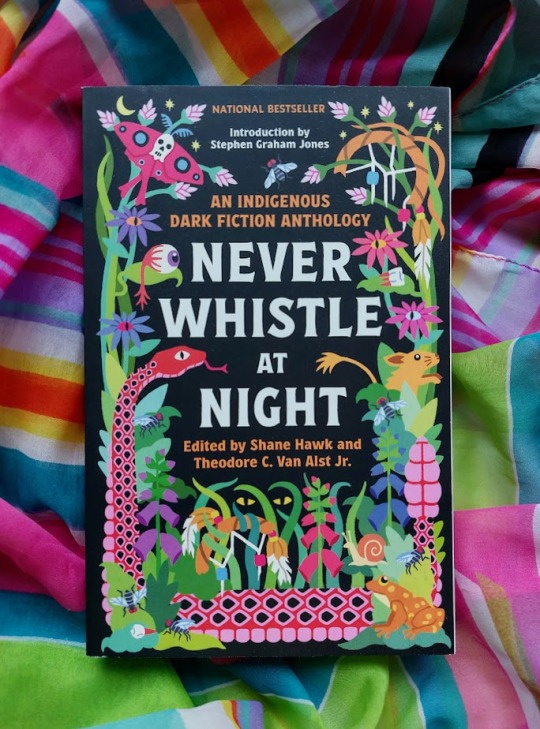
Books of 2024: NEVER WHISTLE AT NIGHT: An Indigenous Dark Fiction Anthology, ed. by Shane Hawk and Theodore C. Van Alst Jr.
This has a bunch of authors I already love in it (Stephen Graham Jones, Darcie Little Badger, Waubgeshig Rice, and Rebecca Roanhorse!!), and several authors I've been meaning to try (like Tommy Orange, Nick Medina, and Kelli Jo Ford, to name a few), so I'm really hyped for them all to be together in one volume! Plus dark fiction is very much my jam (especially when it comes in a bright and colorful package).
#books of 2024#books#book photography#never whistle at night#never whistle at night: an indigenous dark fiction anthology#shane hawk#theodore c. van alst jr.#stephen graham jones#rebecca roanhorse#darcie little badger#waubgeshig rice#i'm sorry i'm not tagging ALL of them lol there are twenty-six (26) stories in here and i do not have the attention span for that many name#i love all the details on the cover too!!#the longer i look at it the more i find#full disclosure: i did in fact used to whistle at night because i don't want to startle creachers directly into my face when i take out--#--the trash or nocturnally shovel snow but uh. i have stopped doing that. since this book hit my shelf lol#(also sorry i just now noticed that the detached human eyeball is PURPLE of all things)#(driscoll posting)#(yeah this was vaguely in the driscoll lineup too#that's where it's been living on my shelf in the meantime)#(right next to OTHER TERRORS lol)#driscoll#in btw#anyway ignore this next text post i'm about to make pretend i'm reading this#and/or doing my damn taxes
26 notes
·
View notes
Text
Have you read...

Many Indigenous people believe that one should never whistle at night. This belief takes many forms: for instance, Native Hawaiians believe it summons the Hukai’po, the spirits of ancient warriors, and Native Mexicans say it calls Lechuza, a witch that can transform into an owl. But what all these legends hold in common is the certainty that whistling at night can cause evil spirits to appear—and even follow you home.
These wholly original and shiver-inducing tales introduce readers to ghosts, curses, hauntings, monstrous creatures, complex family legacies, desperate deeds, and chilling acts of revenge. Introduced and contextualized by bestselling author Stephen Graham Jones, these stories are a celebration of Indigenous peoples’ survival and imagination, and a glorious reveling in all the things an ill-advised whistle might summon.
submit a horror book!
#Never Whistle At Night#Shane Hawk#Theodore C. Van Alst Jr.#horror books#horror#bookblr#books#horrorbookpoll#horror anthology#indigenous horror#indigenous#dark fiction#stephen graham jones#horror short stories
7 notes
·
View notes
Text
Many Indigenous people believe that one should never whistle at night. This belief takes many forms: for instance, Native Hawaiians believe it summons the Hukai’po, the spirits of ancient warriors, and Native Mexicans say it calls Lechuza, a witch that can transform into an owl. But what all these legends hold in common is the certainty that whistling at night can cause evil spirits to appear—and even follow you home.
These wholly original and shiver-inducing tales introduce readers to ghosts, curses, hauntings, monstrous creatures, complex family legacies, desperate deeds, and chilling acts of revenge. Introduced and contextualized by bestselling author Stephen Graham Jones, these stories are a celebration of Indigenous peoples’ survival and imagination, and a glorious reveling in all the things an ill-advised whistle might summon.
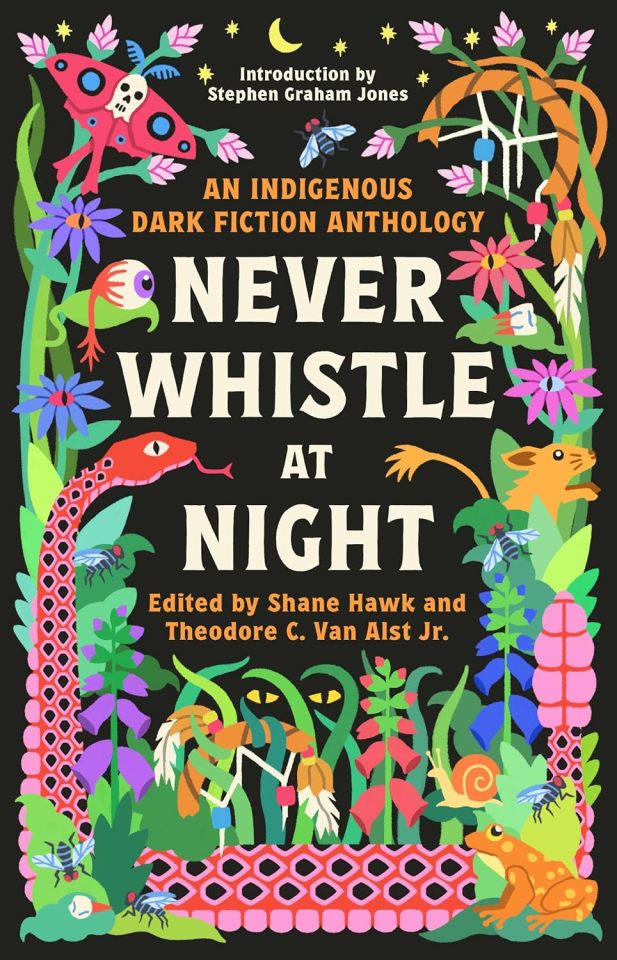
#book: never whistle at night#author: various#genre: horror#genre: short stories#genre: fantasy#genre: mythology#year: 2020s
24 notes
·
View notes
Text
Editor's Note from The Black Sands of Socorro by Patricia A. Jackson

While researching Patricia A. Jackson’s entire body of Star Wars work for a short story anthology, I came across the West End Games sourcebook Star Wars: The Black Sands of Socorro (1997.) It’s a crucial work of Star Wars ephemera: The first creator of color writing for Star Wars in an official capacity, writing not just about individual characters of color, but centering entire cultures populated by non-white characters. A young Black woman in the 1990s wrote science fiction for Star Wars, worldbuilding with concepts like antislavery, indigeneity, linguistic divergence, and settler colonialism...while Disney-Lucasfilm in the 2020s ineffectually positions Star Wars as a post-racial fantasy.
I non-hyperbolically refer to Patricia A. Jackson as the “Octavia Butler of Star Wars,” not because fans of color need to be officially sanctioned by Lucasfilm to create Star Wars content, but because of how difficult it is to carve out anti-racist space in a transmedia storytelling empire. Challenging even in transformational fandom spaces (e.g. fan works), to broach race in affirmational fandom spaces—or while writing content for the property holder—is to be unflinchingly subversive.
And Jackson did it first. In an interview with Rob Wolf in 2022, Jackson described her experience writing race into Star Wars in the 1990s as an “experiment.” The planet, peoples, and cultures of Socorro were a way for Jackson to obliquely, yet concretely, center Blackness and racial justice into Star Wars, pushing the racial allegory constrained by the original trilogy to its limits.
Since it’s inception, Star Wars has spent much of it’s storytelling on the fringes of the galaxy (whether it’s Tatooine or Jakku, Nevarro or Ajan Kloss.) The Black Sands of Socorro is an extension of that trope, but where the Star Wars films used indigeneity as set dressing (eg. “Sand People”, Ewoks, Gungans, etc.) Jackson creates a vivid world where indigenous culture and settler colonists collide; where characters are coded with dark skin and central to the action. The planet Socorro is distinct as a Star Wars setting. As one of the only places in the galaxy where slavery is eradicated with a vengeance, Socorro refuses to let go of a plot line Star Wars media often leaves behind. Socorro is a haven from Imperial fascism, a space where readers are invited to imagine a story that does not center around occupation.
When I learned that Patricia A. Jackson no longer has a physical copy of The Black Sands of Socorro, I realized that I had the materials and the means to create a fanbound hard copy for her home library (well, and also for my own home library.) While this handmade book is not an exact reproduction of the RPG supplement, I hope my renvisioning of the supplement as an in-universe travel guide lives up to the original work.
As the idea of creating a travel guidebook based on the original material percolated, I reflected on the State of Race in Star Wars in the year since I compiled Designs of Fate, an anthology of my favorite Patricia A. Jackson short stories. In May 2022, actress Moses Ingram debuted as Inquisitor Reva Sevander, the deuteragonist in the Dinsey+ streaming Obi-Wan Kenobi series. As predicted by Lucasfilm—and any fan sick of alt-right Star Wars related “whitelash”—Ingram was promptly subjected to a firehose of racialized harassment and misogynoir.
Yep, fascist self-proclaimed fanboys complained about a Black woman Inquisitor in 2022, having no idea (or deliberately whitewashing) that one of creators of the entire freakin’ concept of Inquisitors was a Black woman writing for the Star Wars Adventure Journal three decades ago.
Then, a public facing Star Wars account (@StarWars on Twitter) broke precedent and slapped back at the trolls. Lead actor Ewan McGregor filmed a video retort, posted on @StarWars, stating “racism has no place in this world” and telling off the racist bullies: “you’re no Star Wars fan in my mind.” A few months later, Disney+ debuted it’s second flagship Star Wars streaming series of the year, starring a Latino actor as the protagonist. In the opening episode of Andor, a police chief describes Diego Luna’s eponymous lead as a “dark-featured human,” perhaps the closest the franchise has ever gotten to acknowledging out-of-universe constructions of race, to date. The series explored aspects of imperialism with more depth than Star Wars had previously done on screen, such as the Empire’s treatment of the native people of Aldhani. And, in November, the The Acolyte, a Disney+ series co-developed by Rayne Roberts, announced Amandla Stenberg and Korean actor Lee Jung-jae as its top-billed leads. Stenberg will be the first Gen Z, mixed race, Black, Inuit, queer, and non-binary actor to lead a major Star Wars series.
On the Patricia A. Jackson Star Wars front, in 2022, Jackson’s character Fable Astin was an easter egg in the Obi-Wan Kenobi series. Jackson will again write for Star Wars in an official capacity in From a Certain Point of View: Return of the Jedi, due for publication in Fall 2023. A series about Lando Calrissian, the galaxy’s most famous Socorran, is still in production, so I have my fingers crossed that we may soon see Socorro on camera.
I wonder if this past year will have been a fulcrum year for BIPOC fandom. Maybe Disney has finally realized it’s bad for business that the alt-right uses social media algorithms and Star Wars fan spaces as a soft recruiting ground to radicalize young white men? Maybe Star Wars as a franchise will continue to loudly disavow fan whitelash and firmly position performers of color in true leading roles? I really hope so. On the other hand, as much as I am in favor of increased representation in Star Wars storytelling, I am also troubled by Disney-Lucasfilm’s framing of the Galaxy Far, Far Away (GFFA) as “colorblind.” Recently, Star Wars fans have been asked to accept that in the (a long time ago) sci-fi futurepast GFFA, humans have always been post-racial, and it’s just a coincidence that racialized people were not caught on camera the way white characters have been for years. The galaxy is post-racial and it’s just acoincidence that the movers and shakers of the galaxy have largely been depicted as white men for the past 40 years of media.
For example, in the decade since Disney rebooted the expanded universe, fans have learned that Star Wars’s biggest galactic war criminal to never be depicted on screen is Admiral Rae Sloane, a bisexual Black woman who was the leader of Imperial remnant forces, one of the architects of the First Order, and personal mentor to General Hux. Under Disney-Lucasfilm’s post-racial retcon of the Star Wars universe, the allegorical fascists are intersectional equal opportunity employers (at least in expanded universe content like animation, video games, and novels.) Along those lines, several of the franchise’s newly introduced, prominent women of color have been part of the Empire: Imperial loyalist Cienna Ree (Lost Stars), Inferno Squad leader Iden Versio (Star Wars: Battlefront II) former stormtrooper Jannah (Episode IX), First Order pilot Tamara Ryvora (Star Wars: Resistance), Inquisitor Trilla Sundari (Jedi: Fallen Order), Captain Terisa Kerrill (Star Wars: Squadron) and, most recently, Inquisitor Reva Sevander. Once the sole purview of stodgy, very white and very British men (demonstrably so even in the sequel trilogy movies,) now anyone can be a stooge of the Empire.
That’s not to say that marginalized people can’t collude with fascism, or that there haven’t been heroic characters of color introduced in recent years. Rather, I posit that in order to sell audiences on the post-racial/colorblind GFFA, fascist-of-color characters like Rae Sloane or Giancarlo Esposito’s Moff Gideon (The Mandalorian) are created by necessity. The franchise wants to at once be racially inclusive and yet never directly address race. In Star Wars, real world oppression is primarily explored through allegory—such as Solo (2018)’s bit on droid rights, the clone army, or the myriad of non-human alien bodies that nonetheless are coded with racial stereotypes. A lot has been said about how allegory in sci-fi allows audiences to grapple with inequality from a comfortable distance, and not enough has been said about which audience is being prioritized for comfort.
What does it mean when race is supposedly a non-issue for humans in the GFFA, but creators and actors with marginalized identities cannot participate in Star Wars in any capacity without experiencing identity-targeted harassment? In the past ten years, this has been true even for white women like Kathleen Kennedy and Daisy Ridley, but the vitriol has been most strongly directed towards Black women like Lucasfilm Story Group lead Kiri Hart, author Justina Ireland and The High Republic Show host Krystina Arielle. Can the Galaxy Far, Far Away truly be “colorblind” or “post-racial” (never-racial?) if the narrative continually centers white characters and replicates all the common racial inequities seen in commercialized Hollywood storytelling? Upon the release of The Force Awakens in 2015, critic Andre Seewood aptly described Finn’s positioning in the story as “hyper-tokenism,” even presciently predicting that Finn would continue to be hyper-tokenized in Episodes VIII and IX. As the narrative veered away from Finn, it also left unrealized a stormtrooper rebellion plot line where Finn could have been, in effect, a Black abolitionist. Actor John Boyega’s critique of his experience in the sequel trilogy aligns with Seewald’s assessment: “Do not bring out a Black character, market them to be much more important to the franchise than they are and then have them pushed to the side.”
Published in 1997, The Black Sands of Socorro came before Finn, before Mace Windu, back when all the melanin of Star Wars could be found in Billy Dee Williams’s singular swagger and James Earl Jones’s distinctive voice. Back then, the most prominent Black actress in the original trilogy was dancer Femi Taylor, who played Oola, the hypersexualized green twi’lek fed to the rancor in Return of the Jedi. Bantam Spectra, the publisher that held the license for Star Wars from 1991 to 1999, had no leading characters of color in its’ Expanded Universe. The first full length Star Wars novel by a writer of color, Steven Barnes’s The Cestus Deception15, would not be published until 2004. Even though the book featured two protagonists of color, they would not be depicted on the cover. At Comic-Con in 2010, I spoke with Tom Taylor, a white Australian comic book writer who tried to make the lead family in Star Wars: Invasion (2009) a Black one, but was shut down during the creative process. The comic instead depicts a family of blondes, because the publishers did not think fans would embrace leads of color. All this to say, the inclusion of melanated characters in Star Wars has been so, so hard fought. It’s incredible The Black Sands of Socorro exists at all. It’s more than worthy of celebration, and I’m floored that more attention has not been brought to it.
Patricia A. Jackson is a smuggler.
This sourcebook was explicitly written to assist fans in telling their own Star Wars stories, and in it Patricia A. Jackson smuggled in emphatic allusions to the Black Panther movement and the trans-Atlantic slave trade, smuggled in commentary on indigeneity and settler colonialism, and smuggled in multiple ways for fans to envision characters of color. Her writing has consistently added richness to the GFFA, and in The Black Sands of Socorro she envisions multiple histories for multiple cultures coded as non-white. She ensured the existence of not mere tokens, but flourishing societies of people of color in Star Wars.
The coda for The Last Jedi again shows how perilously close to tokenization characters of color, particularly Black characters, are in modern day Star Wars. In this film, the franchise returns to itsprevious exploration of slavery with the depiction of enslaved children on Canto Bight. The last speaking lines of the film are from Oniho Zaya (played by Josiah Oniha, a young Black British actor) who recounts Luke Skywalker’s heroic exploits to the other children. The film then closes out by showing that one of the downtrodden children is Force-sensitive—a future hero in the Star Wars mythos. In a film where every single Force-user depicted is white, the next generation kid with the potential is, again, a young white boy. Once again, the Black character can only serve the narrative in a supporting role. A franchise depicting a colorblind fantasy continually reifies racial and gender hierarchies in America. With The Acolyte, scheduled for release in 2024, it’s possible the franchise may finally be shifting past hyper-tokenism. In the meantime, fans of color and our erstwhile allies will continue doodling in the margins.
In the end, the sequel trilogy left the Canto Bight plot line (and the overarching slavery plot line started in Episode I) unresolved. I’d like to think the Black Bha’lir strafed Canto Bight and grabbed those kids. It seems like something they would do. Out among the stars, Oniho Zaya is adventuring with Drake Paulsen, and his story does not bracket another characters’; he is central. The Black Sands of Socorro is a launching pad for stories like that. It represents how fans of color have always carved out pieces of Star Wars for ourselves.
#socorro#star wars legends#swrepmatters#star wars adventure journal#star wars d6#patricia a. jackson#fanbinding#binders note
29 notes
·
View notes
Text
Ah, I realized it's Fuck Columbus Day and people are reblogging my old post of indigenous books. I meant to make a new, updated one at some point. So here's a bunch of covers of ones I'd like to read (and one that I have). I'm especially eyeing those anthologies (the first 2 images)


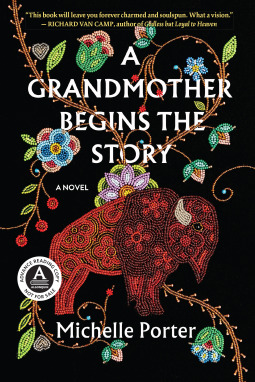
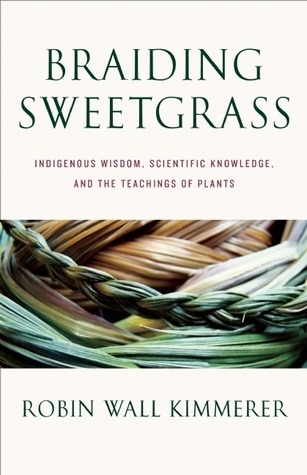

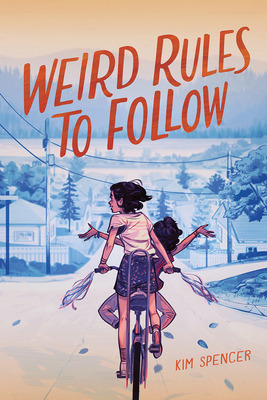
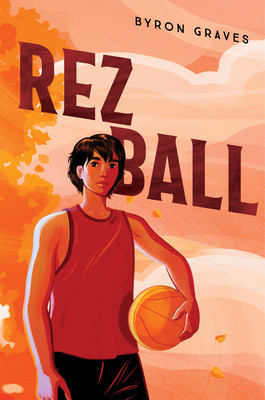
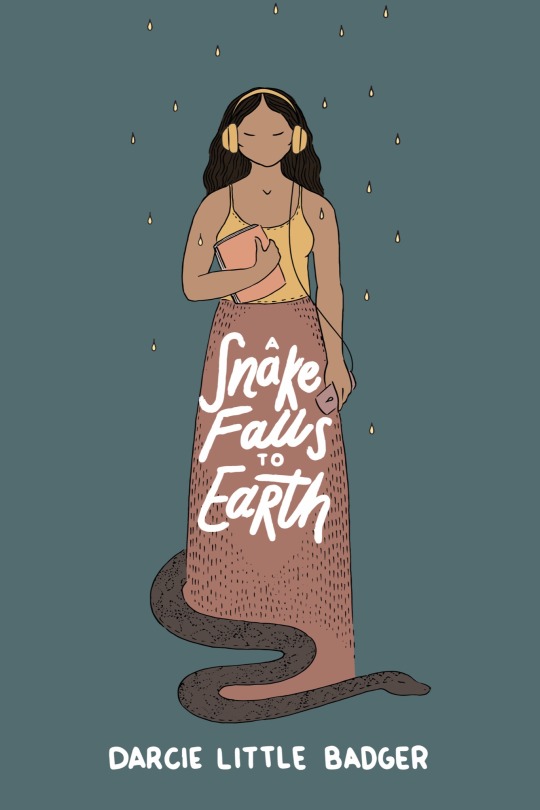

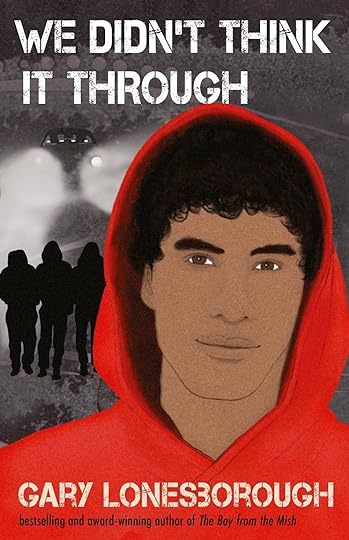


Never Whistle at Night: An Indigenous Dark Fiction Anthology
Love After the End: Two-Spirit Utopias and Dystopias
A Grandmother Begins the Story by Michelle Porter
Braiding Sweetgrass by Robin Wall Kimmerer
The Barren Grounds by David A Robertson
Weird Rules to Follow by Kim Spencer
Rez Ball by Byron Graves
A Snake Falls to Earth by Darcie Little Badger
Warrior Girl Unearthed by Angeline Boulley
We Didn't Think It Through by Gary Lonesborough
Living on Stolen Land by Ambelin Kwaymullina
Fire from the Sky by Moa Backe Astot
#indigenous people's day#indigenous books#first nations#native american#united states#canada#australia#fuck columbus day
43 notes
·
View notes
Note
Hello! I'm really curious, what books/authors would you recommend to someone who's new to writing horror?
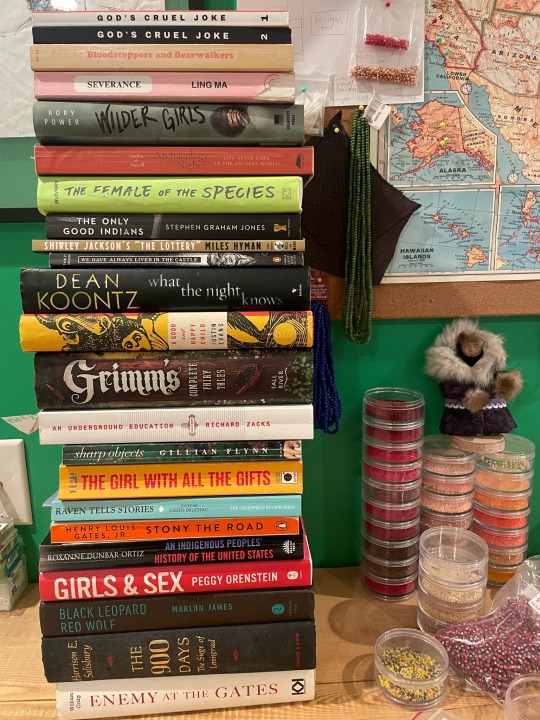
Hi! Here is what I have on hand (minus my loaned out copies of my favorite book ever Mongrels by Stephen Graham Jones and Never Whistle At Night: an indigenous anthology of dark fiction which made me cry on an airplane and made the person next to me very uncomfortable, like she was just trying to build a cart at banana republic, apologies to seat 17B)
God’s Cruel Joke Lit Mag because I’m in them and will be in issue 4, too :) published either mid-January or February 2024– @labyrinthphanlivingafacade is in issue 3 with a great short story that I won’t spoil ***right now the magazines are available to purchase in physical copies but I was told all issues will be free to download as pdfs pretty soon!
Severance by Ling Ma (body horror but not in the way you think, the real horror is repetition and loneliness)
Wilder Girls by Rory Power (body horror)
The Female of the Species by Mindy McGinnis (adjacent the horror genre but a hell of a read)
ANYTHING BY STEPHAN GRAHAM JONES ANYTHING
We Have Always Lived in a Castle by Shirely Jackson (I read this for the first time last spring boy howdy, I also included The Lottery for its suspense)
Dean Koontz because my husband suggested it for the list— this was just the first title I grabbed, I think he said Patrician Crowell too but I was busy looking for Mongrels
A Good and Happy Child by Justin Evans (I didn’t finish this because depression set in shortly after I started but the first chapter plays with second pov which I really liked, I’m determined to read it this year)
Sharp Objects by Gillian Flynn (I really enjoyed HBO’s adaptation)
The Girl With All The Gifts by M.R. Carey (likely the only zombie stories that made me weep uncontrollably)
Girls & Sex by Peggy Orenstein (non-fiction: explores modern young women navigating sexuality and because I have a thing for loss of autonomy— it’s been a few years since I read it but there is discussion of sexual assault, but I appreciate the expanse of her research and even included a conversation with someone who is asexual)
Black Leopard Red Wolf by Marlon James (got a chill just typing this out— the audio book is exquisite)
You’ll notice some nonfiction because, as a historian undergrad, nothing scares me more than man. The battles of Leningrad and Stalingrad are particularly stomach churning. America’s Reconstruction Era is full of acted out malice and under taught in my opinion.
An Indigenous People’s History of the United States by Roxanne Dunbar-Ortiz
The 900 Days, The Siege of Leningrad by Harrison E. Salisbury
Enemy at the Gates by William Craig
(On the other side of WW2 I have a book of the experiences of German solider’s left over from a paper I wrote on the inadequacy of Nazi uniforms and how it expedited their failure in Russia, Frontsoldaten by Stephen G. Fritz)
Stony the Road by Henry Louis Gates, Jr (one of my favorite authors, try finding “How Reconstruction Still Shapes American Racism” Time Magazine, April 2, 2019, I used it as a source for a paper on the history of voting rights)
Bloodstoppers and Bearwalkers— folk tales of Canadians, Lumberjacks & Indians by Richard M. Dorson (published around 1952 but content collected from the Upper Peninsula of Michigan in the 40’s)
Raven Tells Stories: An Anthology of Alaskan Native Writing (I’m Alutiiq and the museum on Kodiak has a lot of stories recorded under Alutiiq Museum Podcast— my kids and I listen on Spotify)
I think the genre of horror is really mastering tension and playing on peoples fears which is why I included old school folk stories (An Underground Education had a great write up on the Grimm Brothers and the original fairy tales from around the world such as the Chinese and Egyptian Cinderella, as well as several different sections of funny tales, torture techniques, absolute weirdos etc etc) in this vein of thought The Uses of Enchanment: The Meaning and Importance of Fairy Tales by Bruno Bettelheim could prove to be useful
If you’re writing a character with Bad Parents— Adult Children of Emotionally Immature Parents and Toxic Parents (it has a longer subtitle but I don’t see my copy anywhere) might be able to help you shape character traits
I reached out to @littleredwritingcat who has a mind plentiful in sources who recommended
The Gathering Dark: an anthology of folk horror (I will be picking this one up asap)
Toll by Cherie Priest (southern gothic)
Anything by Jennifer MacMahon
The Elementals by Michael McDowell
#book recommendations#answered#is that my ask box tag? I never get them and forget everytime lmao#I feel like I should have prefaced this with how I’m just dipping my toes into horror myself#so I’d love to hear what other people are reading too!!!!
27 notes
·
View notes
Text
NEVER WHISTLE AT NIGHT:
AN INDIGENOUS DARK FICTION ANTHOLOGY. ( 1 / ? )
roleplay starters of mathilda zeller's kushtuka.
feel free to edit according to scenario / pronouns.
you don't have to love him, just make his baby.
he'll pay you to keep quiet about it.
the money could really help, you know.
go inside and clean that up. you're getting blood everywhere.
what are you doing here?
there was an accident down in the mines.
they all survived, but they're in really rough shape.
maybe you should come inside.
they're mining into her domain.
their guts were torn out?
and they're saying it was wolves?
what did you do to your hand?
go get the bandages.
i'm sure he'll shoot the biggest caribou known to man.
by the time he gets back to kansas, it'll have turned into a polar bear.
you have a job this weekend.
he needs hired help. you know, cooking, cleaning.
i already told him you'd go. you're going.
that's what i thought.
tell me a native story.
tell me something new.
you call that a ghost story?
i saw it with my own two eyes.
all i hear is you trying to amp me up.
wasn't enough to tell me your ghost stories, you want to spook me now.
you really had me going for a minute there.
you'll love this place.
if they're not his, where did you get them?
there was something outside the house that was clearly murderous and looked just like me.
you clearly need to loosen up.
let me in!
don't. say. a. word.
you're an ugly one, aren't you?
are you dead, or do i need to blast you again?
they were wrong. they were all wrong. i showed them.
he isn't worth what we'll pay for this.
i thought he was going to kill you.
let's take it back to her then, okay?
you, my dear, are most certainly welcome.
#roleplay memes#rp sentence starters#rp memes#short story starters#sentence starters#horror starters#horror meme#horror sentence starters
15 notes
·
View notes
Text
get to know you better game! answer the questions and tag 9 people you want to know better.
tagged by: @ratfink-kryptonite and @likemmmcookies — thank you both for the tag!
last song I listened to: snuff, by slipknot
currently reading: i recently started a dune reread, but next on my list is never whistle at night: an indigenous dark fiction anthology.
currently watching: going to reiterate what @likemmmcookies said with, "does rewatching x files count"? bc i very infrequently watch anything at all, so this is pretty noteworthy. the last thing i watched other than x files was ghost adventures.
currently obsessed with: rose jam on sheep milk yogurt; the x files—specifically krycek whump; this new pork belly recipe we tried; costco boxed wine; the thought of cutting my hair & dying the blonde part green; the rapid approach of spring
tagging: @havenofearoficecoldbeverages @ihni @entelechies @destronomics @prairie-grass @thenameisgreed @formerlyanon @veliseraptor @icannotreadcursive
13 notes
·
View notes
Text
Catalogue Updates and Store News
It's been an exciting time at the store this last month! Between dramatically expanding our catalog, publishing our first in-house book, and going to pop up events, there's been a lot going on!
Publishing Emptied Spaces
We received and shipped nearly three hundred copies of the Emptied Spaces anthology this weekend! I'm really proud of it turned out, and am really looking forward to folks posting about receiving it later in the week. Hopefully it's just the start of future small-print runs from the shop ^^
Confluence Pre-Orders
Confluence is coming up on its release date! From one of our favorite authors, Dr. Bakkalian has done an amazing job of bringing one of her older story ideas to the printed page. It can best be summed up as sword trans lesbians in alt-present Japan fighting against mega-corporations. We're also offering a limited number of signed copies during the pre-order period!
New Titles Round-Up
We've more than doubled our catalogue over the last three weeks, going from twenty ish titles to nearly sixty, including adding several additions to our youth collection! Below are two picks from each of our major book categories to check out ^^
Manga and Comic Titles
A fantastic start to a series of books exploring sapphic sexuality and all the joys and troubles that can come with it.
> The Bride Was a Boy: A very cute book about a trans woman's experience with marriage.
BIPOC Titles
A comprehensive look both at the history and present day Indigenous two-spirit culture.
> Love After the End: An anthology of Indigenous queer and 2S stories, primarily focused on science-fiction stories.
Fantasy
A recent release from one of our favorite publishers, Inflicted is a mini cross-genre anthology dealing with trauma and healing.
> So This is Ever After: An Arthurian-inspired tale about two boys slowly falling for each other while they try to fulfill a magical curse.
Science Fiction
A very esoteric story about the collapse of capitalism and dealing with it as a trans woman in the post-cyberpunk future.
> Otherside Picnic 1: The store had previously carried the omnibus volumes of Otherside Picnic, but we've now begun carrying the manga as well! Two lesbians shoot weird inter-dimensional demons and bond in very pretty environments.
Youth Fiction & Nonfiction
A book geared towards a middle-school audience, following the story of a trans girl trying to figure out how to come out at school.
> The Young Activist's Dictionary of Social Justice: A book geared towards late elementary schoolers and up, it provides easy to understand and illustrated definitions to social justice concepts that may otherwise be difficult to explain to a younger audience.
So What's This About?
If you made it to the end of this and this was a blazed post for you, congrats and thanks! We're a queer bookstore in Wichita KS that does primarily online and popup-event sales at the moment. If any of these books peaked your interest, or if you're interested in checking out the rest of our catalogue, we've begun running a promotion for free shipping on orders over $50 through the end of the year ^^
93 notes
·
View notes
Text
31 Recent Horror Books by BIPOC Authors
Every month Book Club for Masochists: A Readers’ Advisory Podcasts chooses a genre at random and we read and discuss books from that genre. We also put together book lists for each episode/genre that feature works by BIPOC (Black, Indigenous, & People of Colour) authors. All of the lists can be found here. You can also listen to our episode on Horror fiction.
This list features horror fiction by BIPOC authors published within the last 3 years.
Jackal by Erin E. Adams
Vampires of El Norte by Isabel Cañas
The Haunting of Alejandra by V. Castro
The Spite House by Johnny Compton
The Reformatory by Tananarive Due
And Then She Fell by Alicia Elliott
Our Share of Night by Mariana Enríquez, translated by Megan McDowell
Piñata by Leopoldo Gout
Never Whistle at Night: An Indigenous Dark Fiction Anthology edited by Shane Hawk and Theodore C. Van Alst Jr.
Natural Beauty by Ling Ling Huang
The Weight of Blood by Tiffany D. Jackson
Bad Cree by Jessica Johns
My Heart is a Chainsaw by Stephen Graham Jones
The Salt Grows Heavy by Cassandra Khaw
Woman, Eating by Claire Kohda
Lone Women by Victor LaValle
Sisters of the Lost Nation by Nick Medina
Silver Nitrate by Silvia Morena-Garcia
This Thing Between Us by Gus Moreno
Green Fuse Burning by Tiffany Morris
Out There Screaming: An Anthology of New Black Horror edited by Jordan Peele
Flowers for the Sea by Zin E. Rocklyn
Manmade Monsters by Andrea L. Rogers
Monstrilio by Gerardo Sámano Córdova
I Feed Her to the Beast and the Beast Is Me by Jamison Shea
Chlorine by Jade Song
Midnight Storm Moonless Sky: Indigenous Horror Stories by Alex Soop
There's No Way I'd Die First by Lisa Springer
She Is a Haunting by Trang Thanh Tran
Tell Me Pleasant Things about Immortality: Stories by Lindsay Wong
White Horse by Erika T. Wurth
12 notes
·
View notes
Text

Christmas Haul, 2023 Edition!
I am forever and always asking for books for Christmas, and this is what I was gifted this year! (If you think you see me stacking my TBR based on my own writing projects.....yeah okay you do lmao.)
#books#book haul#christmas#do i have a coherent tagging system for this??#i feel like i ask myself this every damn year#and every damn year i cannot recallXD#never whistle at night#an indigenous dark fiction anthology#a taste for poison#neil bradbury#the girl in red#christina henry#the mountain in the sea#ray nayler#the only one NOT directly related to a writing project is the anthology actually#but even then i will be reading it as driscoll adjacent probably#for the Vibes#it's got a BUNCH of authors i already really like in it i'm so stoked!!#and i love finding new faves by way of anthology lmao#perfect samplers
20 notes
·
View notes
Text
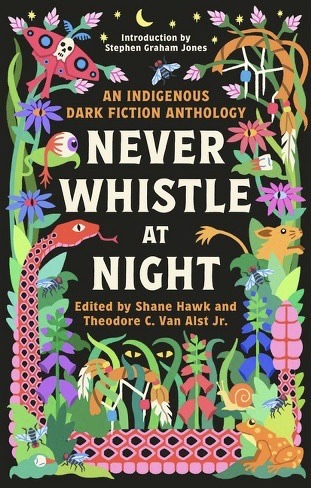
Never Whistle At Night: Review
If You Like Dark Dark Fiction, You’ll Enjoy This; If You Don’t, Best Skip.
Never Whistle At Night is an anthology of dark short stories written by indigenous authors about indigenous characters. I lent my copy to my partner so I don’t have it in front of me at the time of writing this review so I’m going off of memory. I wouldn’t be able to list all the trigger warnings but there’s a lot of them and many of them are very rough. Most of stories are at minimum scary, at most extremely horrifying. I consider myself to have a strong stomach but I almost couldn’t finish the story called Quantum for it’s extremely graphic depiction of child abuse; another tough one was the revenge story called Sundays for its somewhat graphic depiction of child rape. Many stories involve racism and/or violence against indigenous people though most end with the protagonist surviving.
If you like and can stomach extremely dark fiction, you’ll enjoy it. Every story is written wonderfully well and they’re all very different from each other. Some are psychological, some are supernatural, some are just horrifying. At the end of each story is a blurb about the author and information on their other works. It is a great collection that I recommend if you think you can stomach it.
6 notes
·
View notes
Text
What I’m Reading
BOOKS OF OCTOBER
How to Fake It in Hollywood by Ava Wilder
You’re Not Supposed to Die Tonight by Kalynn Bayron
Rabbits by Terry Miles
Elementary: All-New Tales of the Elemental Masters edited by Mercedes Lackey (SS)
The Wizard Killer: Season 1 by Adam Dreece
One Last Stop by Casey McQuiston **
Graphic Novels:
Spy x Family Vol.9-10 by Tatsuya Endo
Sorry For My Familiar Vol.4-7 by Tekka Yaguraba
(128 books read / 125 books goal)
currently reading:
Other Terrors: An Inclusive Anthology edited by Vince A. Liaguno & Rena Mason (SS)
Dunce by Mary Ruefle (P)
Never Whistle at Night: An Indigenous Dark Fiction Anthology edited by Shane Hawk & Theodore C. Van Alst Jr. (SS)
Pop Song: Adventures in Art & Intimacy by Larissa Pham (NF)
The Wizard Killer: Season Two by Adam Dreece
Idlewild by Nick Sagan
Discount Armageddon by Seanan McGuire
Piranesi by Susanna Clarke
* - re-read // ** - 4+ star-rating (recommended)
GN - graphic novel // NF - non-fiction // P - poetry
SS - short story collection // AB - audiobook
TBR:
Gallant by V.E. Schwab
The Gargoyle by Andrew Davidson
Hour of the Crab by Patricia Robertson (SS)
Sunburn by Andi Watson (GN)
Brindille and the Shadow Hunters by Frédéric Brrémaud & Federico Bertolucci (GN)
Lore Olympus Vol.1 by Rachel Smythe (GN)
WHAT ARE YOU READING? :D
Find me on: GOODREADS | THE STORYGRAPH
#books#bookworm#reading#what are you reading#TBR#my books#2023#october#november#reading year 2023#books of 2023#novels#graphic novels#manga#fiction#non fiction#short stories#poetry#romance#contemporary fiction#urban fantasy#science fiction
15 notes
·
View notes
Text
i went to a cool bookstore while visiting anjo and got never whistle at night which is a cool indigenous horror/dark fiction anthology and im rlly liking it but i forgot it at home and i wanna read it during lunch :(
#both anthologies and horror are some of the easiest things for me to read and its So good so far#if anyone has any horror or thriller recs hmu!!
7 notes
·
View notes
Text
OH AND a week or so ago an indigenous horror/dark fiction anthology called never whistle at night was released and it has an introduction by stephen graham jones!!!
#i am so excited for it to be my turn w/ the audiobook#there is So much interesting horror coming out rn i may make a post of my most anticipated ones at some point
7 notes
·
View notes